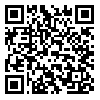Volume 17, Issue 3 (Autumn 2015)
Advances in Cognitive Sciences 2015, 17(3): 12-19 |
Back to browse issues page
1- Assistant Professor of Cognitive Neuroscience, Faculty of Educational sciences and Psychology, University of Tabriz,Tabriz,Iran.
2- Associate Professor of Cognitive Neuroscience, Faculty of Educational sciences and Psychology, University of Tabriz,Tabriz,Iran.
3- Associate Professor of Health Psychology, Faculty of Educational sciences and Psychology, University of Tabriz,Tabriz,Iran.
4- PhD student of Cognitive Neuroscience, Faculty of Educational sciences and Psychology, University of Tabriz
2- Associate Professor of Cognitive Neuroscience, Faculty of Educational sciences and Psychology, University of Tabriz,Tabriz,Iran.
3- Associate Professor of Health Psychology, Faculty of Educational sciences and Psychology, University of Tabriz,Tabriz,Iran.
4- PhD student of Cognitive Neuroscience, Faculty of Educational sciences and Psychology, University of Tabriz
Abstract: (3320 Views)
Introduction: The relationship between quantity and space has indicated in many studies. In European people bigger numbers are associated with right and small numbers with left side Understanding the nature of number processing in is important for developing math curriculums and rehabilitation of dyscalculia. This study is aimed to better understand the number representation in Iranian university students.
Methods: Thirty students participated in this study. They were asked to complete a two block computerized parity task. Each trial was started with a cross in center of screen. Then the cross was replaced by one of the numbers of 0 to 9. In first block they pressed left Shift bottom for even numbers and right for odd numbers. The second block was reverse. The order of blocks was counterbalanced alternatively for all participants.
Results: Analysis of variance showed higher reaction time for right hand (F=12.16, p=0.002). Also even numbers were processed faster than odds (F=24.10, p=0.001). Magnitude analysis showed slower processing for numbers 0, 1, 9 and faster processing for 8 (p & LT; 0.05). Interaction of parity × response side was significant (F=6.48, p=0.001). Post hoc analysis showed significant different between 8 and 9 (p & LT; 0.001) but not between other numbers (p & GT; 0.05). Interaction of magnitude × response side was significant (F=8.32, p=0.001).
Conclusion: Results showed faster response in parity task (about 18ms). Influence of magnitude of numbers on response time was significant only between 0 and 1 and other numbers. This means that magnitude has no automatic effect on response time in parity task. Oddity and MARC effects also were seen. This study did not support the SNARC effect in Iranian people. In summary it is concluded that mental representation of numbers in Iranian people is similar to Hebrew and different from other studied languages. Findings of this study could verify the effect of writing direction on number representation as a cultural product
Methods: Thirty students participated in this study. They were asked to complete a two block computerized parity task. Each trial was started with a cross in center of screen. Then the cross was replaced by one of the numbers of 0 to 9. In first block they pressed left Shift bottom for even numbers and right for odd numbers. The second block was reverse. The order of blocks was counterbalanced alternatively for all participants.
Results: Analysis of variance showed higher reaction time for right hand (F=12.16, p=0.002). Also even numbers were processed faster than odds (F=24.10, p=0.001). Magnitude analysis showed slower processing for numbers 0, 1, 9 and faster processing for 8 (p & LT; 0.05). Interaction of parity × response side was significant (F=6.48, p=0.001). Post hoc analysis showed significant different between 8 and 9 (p & LT; 0.001) but not between other numbers (p & GT; 0.05). Interaction of magnitude × response side was significant (F=8.32, p=0.001).
Conclusion: Results showed faster response in parity task (about 18ms). Influence of magnitude of numbers on response time was significant only between 0 and 1 and other numbers. This means that magnitude has no automatic effect on response time in parity task. Oddity and MARC effects also were seen. This study did not support the SNARC effect in Iranian people. In summary it is concluded that mental representation of numbers in Iranian people is similar to Hebrew and different from other studied languages. Findings of this study could verify the effect of writing direction on number representation as a cultural product
Type of Study: Research |
Subject:
Special
Received: 2015/05/22 | Accepted: 2015/07/23 | Published: 2015/09/23
Received: 2015/05/22 | Accepted: 2015/07/23 | Published: 2015/09/23
| Rights and permissions | |
 |
This work is licensed under a Creative Commons Attribution-NonCommercial 4.0 International License. |


